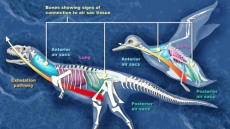The lead that gets accumulated in children's teeth as they inhale dust and ingest soil when they put their hands in their mouths can later reveal where they come from, reveals a study.
Tooth enamel, which develops during childhood, locks in the lead signals and preserves them.
"We can use this pollution signal to figure out where these people came from," said George D. Kamenov, geology researcher at University of Florida.
Lead is composed of four variants, called isotopes. The amount of those isotopes fluctuates in different rocks, soils and ores found in various regions of the world.
"When you grow up, you record the lead signal of the local environment. If you move somewhere else, your isotope will be distinct from the local population," Kamenov added.
The discovery can help police solve cold cases.
For instance, if an unidentified decomposed body is found, testing the lead in the teeth could immediately help focus the investigation on a certain geographic area.
Lead analysis can also tell what time period a body is from.
Modern and historical teeth have different signals, according to the study.
The natural composition of lead changed over the past century because of mining and the use of leaded gasoline, so there is a clear distinction between modern and historical human exposure.
"One can go back in time, look at archaeological sites and try to reconstruct human migration," Kamenov maintained.
The paper is scheduled to be published in the journal Science of The Total Environment.





